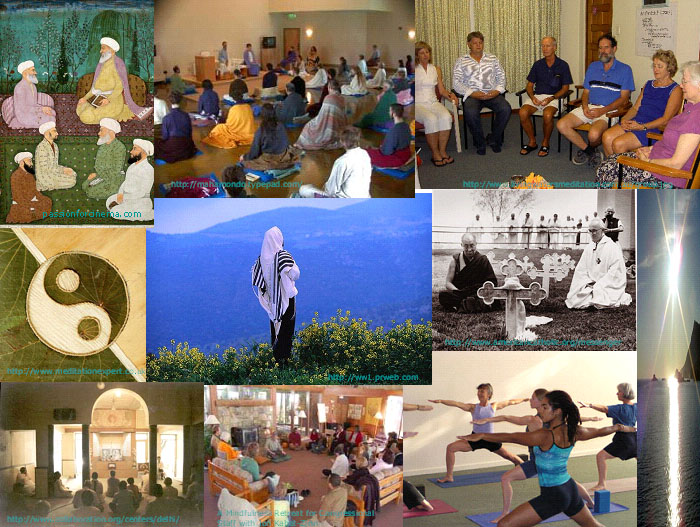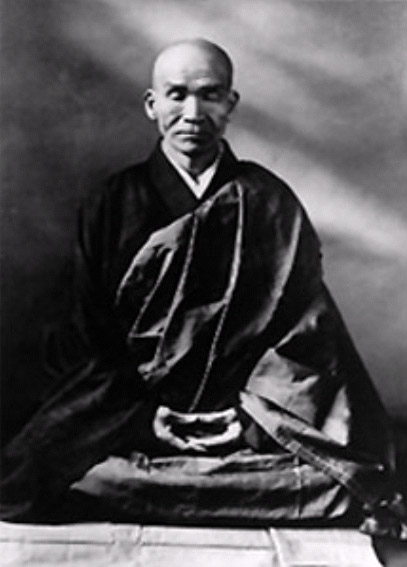Facing the Missing Dimension
The spiritual source shines clear in the light,”
the branching streams flow on in the dark.
- Shitou Xiqian, Sandokai
Sickness accentuates issues that are always with us and that come up at various times in our lives: What is the “me” that is threatened with damage? What is death and how do I relate to it? What is my relationship to everything that is? What is my relationship to those closest to me; do they need and value me? Will they still value me after this is over? What will life be like in the future? A previous article (“Understanding the Missing Dimension”, found under the “Dimensions” tab of this web site) explored what healing practices over the millennia involved beyond the obvious trappings of cultural artifacts and “supernatural” belief systems. Healers traditionally addressed questions like the ones posed above by releasing themselves from day-to-day concerns and connecting with something greater than themselves. They did this by using culture-specific tools such as trance states, healing energy, and appeal to beings other than human. There are probably a variety of ways that the essence of this process could be brought into Western medicine to make our medical practice more whole and more healing. One way to do this without the traditional shaman’s tools is to make an effort to face within ourselves the kinds of questions patients are asking themselves and to do this in ways that take us beyond our own day-to-day ego functions. The term “ego functions” in this context is used broadly to refer to our mind’s functions that organize sensory, emotional and discursive information in ways that make sense to us so we can function in this complex world. It includes such things as sensory perception, comparative thinking, planning, self image, stories about the self, values, meaning and understandings of how things work. It also includes making plans and adapting them as we carry them out. These are admittedly important and compelling activities of the mind. But as long as we are continuously engrossed in them, we cannot look deeply at our lives.
One approach to releasing the grip of ego functions in order to explore the fundamental nature of our lives is to practice mindfulness based insight meditation. By using this approach, it is possible to understand ourselves better. As a meditation practice unfolds over the years, we do connect more and more with something larger than ourselves – only to discover that it is none other than ourselves. From the perspective that the sustained practice of mindfulness meditation gives us, the answers to questions like “What is the ‘me’ that is threatened with damage?” become either intuitively obvious or irrelevant. We can also connect to a deep desire to try to be of help, and we may be able to become a more healing presence than we would have been if focusing only on being technically competent.
A Zen Based Approach
One approach to practicing meditation and understanding life, sickness and death at a deeper level is through Soto Zen practice. In some ways it would be better to write from the perspective of a physician with 30 years of intensive Zen practice but this is not possible since my practice has been only moderate and for 10 years. Nonetheless, such a viewpoint may be realistic and useful because it would be difficult to sustain a medical practice while practicing Zen intensively for 30 years, especially if one decides to spend time with friends and family. What is written here is heavily influenced by the guidance and teachings of my sensei, Josho Pat Phelan, as well as many writings, particularly those of Thich Nhat Hanh, Suzuki Roshi and Katagiri Roshi. This is what taking a path means – others have walked it before. It is important to stress that my point of view is definitely not that Zen is the only approach to deepening one’s experience as a physician or becoming enlightened. There are many other Buddhist traditions, other contemplative religious traditions and some secular approaches about which similar treatises could probably be written. I just cannot write authentically about other traditions.

There are many religious and secular paths that support spiritual development and emotional maturation. URL’s on images can be visited for more information.
Zen is at its heart nonverbal and non-conceptual. To practice Soto Zen meditation is to set aside the words, definitions, conventions and concepts that allow us to impose sense on the world and function in it. We set all this aside and just sit, watching our experience of life arise and pass. All of our experience arises as some mixture of sensations and mental activities. In meditation we do not engage or attach to mental activity; we just let it subside to a trickle and watch it. Our sensations arise continually and draw us into the present moment.
One way to look at this practice is with reference to the sentiment widely understood in our culture that we can be saved or liberated by giving ourselves over to a higher power. In meditation we put aside resistance to and manipulation of whatever is in this moment and sit while being as mindful (aware) as possible. This is done with the intention to embrace the flow of our experience precisely when it is really happening. This experience includes our senses, emotions, thoughts and even physical and emotional pain. Our absolute experience of this life just as it arises is the higher power. It arises before we judge it, before we interpret it, before we like or dislike it, even before we perceive it. (By “perceive” I mean organize sensory experience at a very basic level.) This experience also includes perceptions, likes, dislikes, judgments and interpretations, all of which arise following some stimulus like so many aftershocks. Although we conceive of a separate “me” that is experiencing things, “me” is continually being shaped by this seamless and continuous arising of sensations and mental formations. Without this arising, no me would be arising. No matter what strategies we use to try to escape and control our experience, our experience of life cannot be satisfactorily manipulated, escaped or controlled. Our relationship to this greater power cannot be fully understood by our thinking minds.
Giving ourselves over to this great source of the self and trusting in it to the extent we can gives us a new vantage point nearer the base of consciousness from which to start to become more aware of our ego functions. From this perspective we try to get to know ourselves in a friendly way that is relatively nonjudgmental and unbiased. Opportunities continually arise for getting glimpses of ourselves from this vantage point both during meditation and in daily life. These glimpses let us see what we are really like and what the world around us is really like. The process is usually very long term. We say “delusions are inexhaustible; I vow to end them” reflecting the protracted nature of this kind of personal development and the lack of a final destination. The new vantage point near the base of consciousness tends to become stronger and more stable with practice and as we become more at home there it allows a progressively deeper connection with the vast, vibrant and timeless nature of ourselves and indeed of the whole universe from which we arise.
Zen practice may integrate into daily life at least for some people in a way that is cyclical. As we are mindful of thoughts and emotional reactions we have opportunities to see that they are very habitual and are a little off base sometimes, causing unnecessary negative feelings and unnecessary difficulties. Focusing mindfulness on our intentions and actions as they relate to Buddhist precepts (for instance non-killing, truthfulness, considerate and constructive sexuality) is a part of this practice. Here are some examples of things one might realize as practice plays out in daily life:
- The habit of always finding something unsatisfactory to either change or be unhappy about diverts attention from what is good and real.
- The same is true of continually wanting things we don’t have.
- Many of our conditioned likes and dislikes serve no useful purpose; to drop them is liberation.
- To see something without feeling attachment or aversion is quite beautiful.
- Doing harm is at some level painful to the doer.
- Unfriendliness to others is based in fear and in unfriendliness to ourselves.
- Much of our mental energy expended on superimposing meaning on our experience is wasted energy and detracts from enjoying our lives.
- Our minds create all problems; we should be careful which problems we create.
Bringing our habitual confusion, wasted effort and harmful actions into awareness can lead to these habits simply fizzling out. Mindfulness may also lead us to realize that we are not quite who we thought we were, and this may be hard to accept. This process of realizing new things about ourselves and our lives may go on for a while. As our realizations accumulate, we change over time. Then, sometimes during our usual activities or sometimes during meditation (especially extended meditation), what Katagiri Roshi called “the song of the universe” may break through. We experience “suchness” (the absolute reality of the moment) a little more clearly than before or as Ehei Dogen stated “myriad things step forth and express themselves”. Having weakened the ability of thoughts and emotions to divert us by fooling us into believing that they represent actual reality, through the senses we touch the vibrant and vast nature of everything a little more deeply. Through the senses we enter more deeply the living, rushing flow of the present moment. The experience can be quite sudden but different people may experience this in different ways that may be subtle or dramatic. As a group, the practitioners I know do not tend to dwell on the particular way these experiences manifest in an individual and I feel quite skeptical that dramatic experiences are necessary for deep understanding and great transformation to develop over decades.
Perceiving better our vast, changing, timeless nature leads to shifts in how we perceive ourselves and our relationship to everything. The effect may be disorienting and require a period of adjustment. Then the cycle repeats. Being mindful of the activities of the self, this new person sees new things about the small self and transforms so the small self is obscuring suchness even less. The song of the universe becomes yet clearer and less intermittent. My guess is that there may be no end to this process as long as we make the effort to continue it. Classical Zen writings tend to expound mainly on the part of the cycle having to do with the sudden clarity of absolute reality. There seems to be relatively little written of the difficulties of adapting to these rapid changes in orientation. My own experience has been that these shifts can be associated with a pretty frightening and difficult feeling of breaking up on re-entry and with a period of readjustment. A poem by Izumi Shikibu captures this paradox of exposure to emotional winds as reality breaks through:
Although the wind”
blows terribly here,
the moonlight also leaks
between the roof planks
of this ruined house.

Photo by Clay and Brian Sherrod. (link)
I do not know how intensely other people who practice Zen experience this “wind”. But it seems to me that it must be pretty common. The well known religious figure Ekhart Tolle is said to have spent 2 years mostly on a park bench after an “awakening experience”. Adyashanti describes a process of re-adaptation proceeding over several years. If other beings heavily depend on us at the point we start practice, we should practice carefully.
Some Ways Zen Practice May Help a Healer
Patient care is basically exciting and satisfying. At each encounter a one-of-a-kind character is coming to you with a unique problem and looking to you for help. The person has a unique story and usually looks at his problem as important and at what you are doing as important. Patients will tell you about things that they would rarely tell another person – bodily functions, fears, behaviors they are ashamed of, problematic relationships, emotional problems. All you have to do is listen wholeheartedly and do your best to help and they will almost always be appreciative. Yet it is common for healthcare providers to burn out or find some problems uninteresting. Zen practice may help by supporting a freshness and openness with each person encountered.
A core teaching of Soto Zen in this country is that of “beginner’s mind”. As Shunryu Suzuki said “If your mind is empty, it is always ready for anything; in the mind of the beginner there are many possibilities; in the mind of the expert there are few”. In this case empty does not mean ignorant; it means free of preconceived notions. The beginning medical student may encounter a diabetic’s foot ulcer and be quite interested. How did it happen? How could this not hurt? How could you really know whether or not it is infected? What if an amputation is required; how would this affect the patient’s life? What would such a thing be like if it was me? Actually all of these questions are relevant almost every time but someone who sees a lot of diabetic foot ulcers is likely to feel pretty bored and say “it’s a diabetic foot ulcer that can be probed to bone. This means osteomyelitis and it should be managed by …” The expert by distilling the issues down to a few possibilities is further from the reality of the problem than the student was. Each patient is a person with a constellation of presenting factors that have never occurred quite this way in the history of the world. Seeing the uniqueness of each patient and problem enriches the experience of being a doctor and helps us address what the patient needs addressed. Unfortunately some hold up as ideal the expert who right away with great confidence despite little reflection decides how to pigeon-hole what is going on and what to do. By intellectualizing and “knowing” what is going on, the expert is setting himself up not to notice what is there and not to notice when things don’t go according to plan. If you know what is going on and exactly what to do about it, why bother monitoring to see if you were right? The true mystery of every situation is not being felt. Every month spent as a medicine attending I see some hospitalized patients who are getting worse instead of better unnoticed because in the mind of an expert they are not supposed to be getting worse. Most months as infectious diseases consultants we see patients who “crashed” with sepsis, but if you look carefully at what was documented, there were often plenty of signs. Beginner’s mind is good for us because we can stay in touch with what is truly happening and it makes medicine more interesting. It is also good for the patients. As with a lot of Zen teachings, especially for those of us in academics there is a temptation to say “Oh I get that. Now I know all about beginner’s mind.” Ironically one can quickly become an expert at beginner’s mind. The point of this teaching is to lead us to notice in ourselves what is getting in the way of our beginner’s mind; it is a very long term project. I don’t think there is anyone who can’t benefit from reminding themselves about it from time to time.
Most of us have busy lives. On a given day there are multiple agendas and events, some of them emotion laden. Thus, when we see a patient there may be other things going on in our minds competing for attention. When I was younger with a research lab and my retention and promotion depended on performance in the lab, it was sometimes difficult to give the attention to patients that their suffering called for and difficult to be present for the house staff. For many medical school faculty I think an agenda of achieving acclaim is foremost. The academic culture tends to reinforce this priority. There are many other distractions. If there are too many patients scheduled just the thought of moving things along can dominate over “how can I help you?” Troubles at home or conflicts at work can create a toxic state of mind. Unilateral administrative decisions that affect our work and about which we are disrespectfully not consulted can make our lives difficult and create a pervasive feeling of annoyance. Concentration and mindfulness of mental activity are foundations of meditation; in this way we remain alert and fully engaged. To do any activity fully engaged and wholeheartedly is, as in meditation, a key to bringing awareness into our daily lives. This is one reason that meditation practice is called practice. We are practicing for other situations, too. In this way meditation practice helps us to bring full attention to the patients.
Recently my friend Paul Boyle, a priest at Chapel Hill Zen Center and director of the X-ray diffraction lab at North Carolina State University, reminded me that Buddhism deals with our own attachments and aversions at a basic level that is maybe analogous to working at the level of machine language programming for computers. Attachments and aversions are considered the central modifiable source of human suffering. There is no denying that when a patient to whom we have a real aversion gets admitted to our service or comes to our clinic we suffer. We can use mindfulness skills to experience that aversion fully, in all of its aspects, and to watch over and over again for details of how it arises. We can try to see what the necessary conditions are. My own experience is that confronting these aversions can be pretty difficult and personal. The patient may not affirm who I think I am and not see me how I want to be perceived. Alternatively, the person may portray some aspect of myself I would rather not acknowledge or may behave so as to dash my expectations for outcomes. Mindfulness is often thought of as a short term strategy to relieve stress and feel good, but the truth is not so frivolous. It may be painful to really become aware of why we have turned a blind eye to suffering. We may have to relax our hold on part of who we think we are and decide to change. In the long run, though, being freed from aversion can free us up to embrace and fully wish to help someone who is coming for help. It opens the possibility of better enjoying being with our patients.
One thing that can limit our effectiveness with patients and sometimes leads to aversion is a fear of death. The psychoanalysts sometimes state that the root source of all fear is the fear of death. I think that in a way they are right. When fear is examined closely it always seems to be in some way fear of the destruction of the self; death is an extreme example that tends to come up when we experience any fear. If some part of the self is threatened, it is very painful. This is why we may argue vociferously for the ideas we identify with or try so hard to be a “winner”. But the self we think we are in conventional daily life is only one aspect of what we are. The psychoanalysts speak of the subconscious mind and there is an understanding that bringing it to light is helpful to people. They help people dig through the subconscious to find aspects of themselves that contradict who they consciously identify themselves as being. At least that is my understanding. Bringing the unconscious mind to light is a part of Zen practice. It just happens; it is not something that we are necessarily trying to accomplish per se. But we encounter it when we touch something deeper than the subconscious – the vibrant and vast core of our existence that also expresses itself as suchness because it is the vibrant core of everything. This foundation of consciousness is timeless; it seems to extend everywhere into the depths of consciousness and throughout space so space and consciousness seem one and the same and it supersedes our life and death. The incrementally deeper touching of this core of existence seems to incrementally lessen the fear of loss of the conventional self and of death. The conventional self is actually very small in comparison with the boundless foundation of consciousness, for which death is an irrelevant concept. Touching and assimilating this foundation of consciousness dissolves many of our fears. Being with someone who does not totally share their fears can be reassuring to patients.

Looking outward and looking inward we see the same vast and alive spaciousness; it is our boundless nature. Sombrero galaxy as seen through the Hubble telescope. (link)
Thich Nhat Hanh uses the term “listening deeply” to describe how family members should listen to each other. This is listening we do with beginner’s mind trying to understand what is meant and what is between the lines with regards to both content and emotion. We are not thinking of our next brilliant comment or question while listening deeply nor concluding yet what the spoken words and body language are really about. Many people may have virtually no one besides their doctor in their lives who will listen to them in that way and as mentioned above, patients bring us problems that they do not feel comfortable discussing with anyone else. Listening deeply is one of the most effective healing interventions we have to offer and this skill can be sharpened through the concentration, mindfulness and silence of formal meditation practice.
As mentioned above, if we are lucky some of the tacit rules that we identify with and that require others to validate us fall away – self imposed rules that allow us to be easily threatened. As practice matures we may find ourselves better enjoying interactions with everybody as a “person without rank”. Interestingly, to the extent this has happened to me it has not led to disrespect from others; quite the opposite. It seems appropriate for most attending physicians to try to embody this attitude. Many studies and a meta-analysis have shown that on the average the maximal knowledge base a physician will ever have is what he or she has within a few short years of finishing training. This is partly because the half life of medical knowledge is actually quite short. Much of what we think we know soon turns out to be untrue or becomes obsolete. Doing the best for the patient is truly a group effort among equals. Also, people are more interesting when not being talked down to and we can listen better when not processing information with the goal of maintaining our image and social position. It makes interactions more relaxed and enjoyable. Being in touch with our delusional rules also allows us to identify more accurately when someone is really treating us in a disrespectful or shoddy manner and to stand up for ourselves or decide not to, depending on what the situation requires.
Balancing Zen with Medicine
Practicing Zen can also create difficulties for physicians, especially in academics. Although Buddhist practice can deepen the experience of being a physician, there is a potential for it to make one’s efforts less in line with institutional goals. The relationship between productivity and the suffering of neurosis has been recognized at least since 1930, when Sigmund Freud wrote Civilization and Its Discontents. One thing that often happens over time with Buddhist practice is that neuroses tend to fizzle out. Especially in the academic setting, much of ambition seems to be fueled by neurosis. As a sign of this tendency, many people have pointed out that in academics the feelings are strong when the stakes are low. For those of us in academics, the saying is so true it makes us chuckle. When neurosis and ambition fizzle together, major life readjustments may be necessary. I experienced this with my research. I was capable, enjoyed bench work and writing papers, had true curiosity, found the work interesting and enjoyed running a research group. However, the great effort required was partially fueled by neurosis and when I recognized that my ambition was starting to fade, I had to give up research because these days, at least for me, it is just too competitive to succeed without the added drive of fully charged ambition. The process accelerated the year my house burned to the ground, starkly reminding me of what was really important.
There is a closely related problem. My esteemed colleague of many years, Dr. John Hamilton, was once interviewed by the local newspaper and was asked to what he attributed his research success. His answer was simply “time to reflect”. This was during the late 1980’s. We also used to take time to eat lunch together and with other colleagues. Sometimes we would go to the gym at lunch time to exercise. Every Friday afternoon before leaving for home we and other co-workers would gather for wine and cheese in our research space at the VA Medical Center (the statute of limitations applies). Across the street at Duke, colleagues got together weekly in Duke Gardens for port wine and cigars and sometimes we ate lunch with our colleagues based at Duke Medical Center. Every month or two, when there was a special occasion, someone (usually John) would foot the bill to take everyone to lunch. There is now no time for any of this. When I do go to the cafeteria, there are no colleagues with whom to eat. We are all too busy. Despite this, I occasionally hear negative comments or insinuations about how someone or some group is not working hard enough. For many people at Duke, the atmosphere is one of being driven to work so hard as not to find work as enjoyable or satisfying as it could be. I was recently at a function with several of my colleagues and one of them was disturbed because she had gone home the evening before and had been too drained to really want to spend time with her 2 year old child. Time spent with the child had been just another thing to do after already doing too much. This was very sad and I asked aloud “How could you do your job without being totally drained of life?” Immediately three of the four other faculty members within hearing affirmed that they wanted to know the answer, too. But no one had the answer.
A really legitimate question, then, is - How does this kind of heavy workload mesh with Zen practice? The same question applies to mindfulness based stress reduction, which was derived from Buddhist practice, and other contemplative religious practices. People often seem to imagine that by adding meditation practice to our busy schedules we can increase our resilience and make life better. Shunryu Suzuki, for one, cautioned against overdoing it, though. Addressing the question of adding intensive Zen practice to an already busy life, his dharma talk quoted in Zen Mind, Beginner’s Mind states “If your practice makes you worse, it is ridiculous”. He recommended not practicing too intensely, not pushing too hard especially not for attainment. However, for many people there may come a point when practice takes a good bit of time if they are serious about it and this effort can lead to time conflicts and overload. Furthermore, becoming more aware of ourselves means becoming more aware of our suffering. If you work so hard you feel drained, this is suffering. If you come home so drained you cannot wholeheartedly embrace your family, this is suffering. If we value compassion, we should value compassion for ourselves as well as others and address this suffering. Also, working very hard slows down the development of self-understanding. If we are too busy, it will be difficult to practice meaningfully because there is no space for insight and personal growth to develop. Beyond all this high talk of optimizing Zen practice and “space for insight”, isn’t it just common sense that we want our lives to be satisfying and enjoyable? Two years ago I de-escalated from working 9/8 time to 6/8 time. As a result I now more fully enjoy seeing patients and working with the house staff, who are really quite wonderful. My Zen practice seems to be bearing more fruit as well, though I have to admit that holding the fruit of practice up as a goal is not a good idea because it is so unpredictable. There is no convenient answer. Clinging to superior productivity and acclaim do not help Zen practice and visa versa. I strongly suspect that the same holds true for other paths to emotional and spiritual development. On the other hand, any academic medical center finds itself in a competitive environment and if it is to remain viable must have many highly motivated, creative and hard working people. A major question that needs to be addressed by academic centers is how fostering the emotional and spiritual maturation of its faculty, trainees and providers can be reconciled with the current bottom lines – revenues, grants and papers. Perhaps our leaders want to find a way and will do so. Given the brevity of life, they should not ask their followers to turn their backs on important maturational and spiritual issues for too long. Finding the right balance is truly difficult, but it is important for the quality of our personal and collective lives.

Shikantaza (zazen) – Just sitting. Kodo Sawaki is in zazen (Zen meditation) posture; the image of Sawaki is widely distributed on the web.
Acknowledgement: I thank Josho Pat Phelan for reviewing this manuscript.
© 2009, 2010 Kenneth H. Wilson



